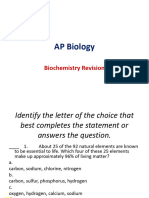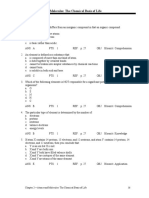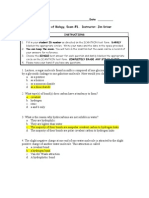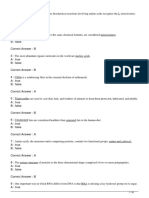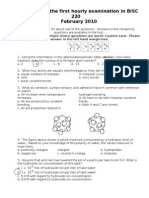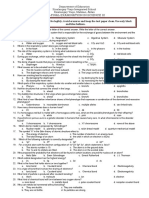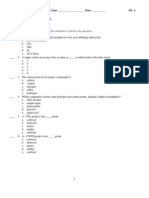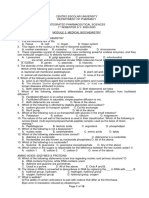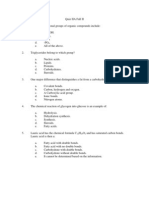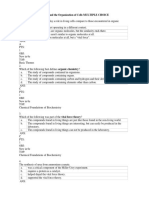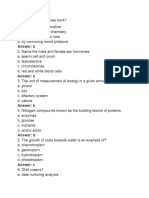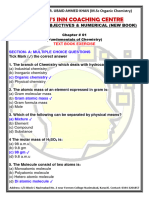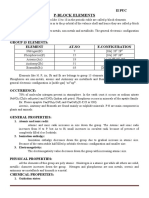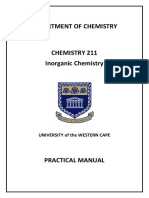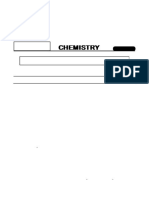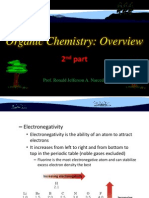Chapter 3-The Chemistry of Life: Organic Compounds: Multiple Choice
Chapter 3-The Chemistry of Life: Organic Compounds: Multiple Choice
Uploaded by
Razane AbouzaidCopyright:
Available Formats
Chapter 3-The Chemistry of Life: Organic Compounds: Multiple Choice
Chapter 3-The Chemistry of Life: Organic Compounds: Multiple Choice
Uploaded by
Razane AbouzaidOriginal Title
Copyright
Available Formats
Share this document
Did you find this document useful?
Is this content inappropriate?
Copyright:
Available Formats
Chapter 3-The Chemistry of Life: Organic Compounds: Multiple Choice
Chapter 3-The Chemistry of Life: Organic Compounds: Multiple Choice
Uploaded by
Razane AbouzaidCopyright:
Available Formats
Chapter 3—The Chemistry of Life: Organic Compounds
MULTIPLE CHOICE
1. Which of the following is not a property of carbon?
a. Carbon-to-carbon bonds are limited to single bonds.
b. Carbon has four valence electrons.
c. Carbon can form bonds to various other atoms.
d. Two carbon atoms can share three electron pairs with each other.
e. Carbon-to-carbon bonds are strong.
ANS: A PTS: 1 REF: p. 47 OBJ: Bloom's: Knowledge
2. The number of electron pairs shared between carbon 2 and 3 in the accompanying figure is:
a. one.
b. one and a half.
c. two.
d. three.
e. four
ANS: C PTS: 1 REF: p. 48 OBJ: Bloom's: Comprehension
3. The two molecules in the following figure represent:
a. ionized structures.
b. enantiomers.
c. secondary structures.
d. geometric isomers.
e. polymers.
ANS: D PTS: 1 REF: p. 48-49 OBJ: Bloom's: Comprehension
4. The highly polarized nature of compounds containing carboxyl groups can be attributed to the
presence of two:
a. highly electronegative carbon atoms.
b. highly electropositive carbon atoms.
c. highly electronegative oxygen atoms.
d. highly electropositive oxygen atoms.
e. highly electropositive nitrogen atoms.
ANS: C PTS: 1 REF: p. 49 OBJ: Bloom's: Knowledge
Chapter 3—The Chemistry of Life: Organic Compounds 31
5. This functional group is weakly basic because it can accept an H + ion:
a. hydroxyl
b. carbonyl
c. amino
d. phosphate
e. sulfhydryl
ANS: C PTS: 1 REF: p. 50 OBJ: Bloom's: Knowledge
6. Hydrocarbons are hydrophobic because:
a. the covalent bonds between hydrogen and carbon are nonpolar.
b. they contain oxygen atoms.
c. they exist as isomers.
d. the covalent bonds between carbon atoms are polar.
e. the hydrogen bonds between hydrogen and carbon are nonpolar.
ANS: A PTS: 1 REF: p. 48 OBJ: Bloom's: Comprehension
7. The chemical interactions of large organic molecules are largely determined by:
a. their solubility in water.
b. their functional groups.
c. their polar nature.
d. isomerization of these hydrocarbons into other forms.
e. the hydrogens bonded to the carbon atoms.
ANS: B PTS: 1 REF: p. 49 OBJ: Bloom's: Comprehension
8. Which of these terms is most inclusive?
a. monosaccharide
b. starch
c. polysaccharide
d. disaccharide
e. carbohydrate
ANS: E PTS: 1 REF: p. 51-52 OBJ: Bloom's: Comprehension
9. Carbohydrate molecules:
a. serve as structural components of human cell walls.
b. form the regulatory compounds known as enzymes.
c. are a source of energy.
d. help protect vital organs from damage.
e. contain the genetic information of a cell.
ANS: C PTS: 1 REF: p. 51 OBJ: Bloom's: Knowledge
10. A chemical reaction in which polymers are synthesized from their building blocks is called:
a. hydrolysis.
b. condensation.
c. oxidation.
d. reduction.
e. dissociation.
ANS: B PTS: 1 REF: p. 51 OBJ: Bloom's: Knowledge
Chapter 3—The Chemistry of Life: Organic Compounds 32
Figure 3-1
Use the figure below to answer the corresponding question(s).
11. The process illustrated in Figure 3-1 is called:
a. condensation.
b. protein synthesis.
c. hydrolysis.
d. dehydration synthesis.
e. denaturation.
ANS: C PTS: 1 REF: p. 51 OBJ: Bloom's: Application
12. The products of the process in Figure 3-1 are:
a. amino acids.
b. molecules of glycerol.
c. representative of a glycoside linkage.
d. enzymes.
e. monosaccharides.
ANS: E PTS: 1 REF: p. 51 OBJ: Bloom's: Application
13. In which of the following reactions must the equivalent of a water molecule be added in order to break
a bond?
a. fatty acids + glycerol fat
b. glucose + fructose sucrose
c. glycogen glucose
d. alanine + glycine dipeptide
e. glucose cellulose
ANS: C PTS: 1 REF: p. 51 OBJ: Bloom's: Application
14. Which of the following illustrates hydrolysis?
a. the reaction of two monosaccharides to form a disaccharide
b. the reaction of two amino acids to form a dipeptide
c. the reaction of a hydrogen atom and a hydroxide ion to form water
d. the reaction of a fat to form glycerol and fatty acids
e. the formation of ATP from ADP and inorganic phosphate
ANS: D PTS: 1 REF: p. 51 | p. 57 OBJ: Bloom's: Comprehension
Chapter 3—The Chemistry of Life: Organic Compounds 33
15. Glucose dissolves in water because:
a. it ionizes.
b. it is a polysaccharide.
c. it has polar hydroxyl groups that interact with polar water molecules.
d. it has a very reactive primary structure.
e. it is hydrophobic.
ANS: C PTS: 1 REF: p. 52 OBJ: Bloom's: Application
16. The difference between a hexose and a pentose is that:
a. a hexose is saturated, and a pentose is undersaturated.
b. a hexose is hydrophilic, and a pentose is hydrophobic.
c. a hexose always has six hydroxyl groups, and a pentose always has five.
d. a hexose always has six carbons, but a pentose always has five carbons.
e. a hexose can be polymerized, but a pentose cannot.
ANS: D PTS: 1 REF: p. 52 OBJ: Bloom's: Comprehension
17. Monosaccharides are water soluble because:
a. they contain a large number of methyl groups.
b. they have a large number of polar hydroxyl groups.
c. they have at least one double bond between adjacent carbons.
d. they have large numbers of nonpolar carbons in their backbones.
e. they can form ring structures.
ANS: B PTS: 1 REF: p. 52 OBJ: Bloom's: Comprehension
18. Which pair is mismatched?
a. monsaccharidemaltose
b. disaccharidesucrose
c. polysaccharidecellulose
d. hexoseglucose
e. pentoseribose
ANS: A PTS: 1 REF: p. 53 OBJ: Bloom's: Comprehension
19. Which one of the following carbohydrates is the most structurally complex?
a. sucrose
b. fructose
c. cellulose
d. glucose
e. a disaccharide
ANS: C PTS: 1 REF: p. 54 OBJ: Bloom's: Comprehension
20. Amyloplasts are organelles that store:
a. fat.
b. starch.
c. protein.
d. lipids.
e. DNA.
ANS: B PTS: 1 REF: p. 54 OBJ: Bloom's: Knowledge
Chapter 3—The Chemistry of Life: Organic Compounds 34
21. A carbohydrate energy storage molecule found in animal liver and muscle cells is:
a. starch.
b. glycogen.
c. cellulose.
d. a fatty acid.
e. cholesterol.
ANS: B PTS: 1 REF: p. 54 OBJ: Bloom's: Comprehension
22. What macromolecule is composed entirely of beta-glucose units?
a. starch
b. chitin
c. glycogen
d. cellulose
e. protein
ANS: D PTS: 1 REF: p. 54 OBJ: Bloom's: Knowledge
23. Which of the following is NOT true of lipids?
a. They store energy.
b. They function as structural components of cellular membranes.
c. They function as hormones.
d. They are nonpolar.
e. They have many oxygen-containing functional groups.
ANS: E PTS: 1 REF: p. 56 OBJ: Bloom's: Knowledge
24. The hydrolysis of triacylglycerol will yield:
a. three fatty acids and one glycerol.
b. three glycerols and one fatty acid.
c. two fatty acids and three glycerols.
d. one fatty acid, one amino acid, and one glucose.
e. one fatty acid, one phosphate, and one glycerol.
ANS: A PTS: 1 REF: p. 57 OBJ: Bloom's: Comprehension
25. Which of the following molecules is not grouped with the lipids?
a. prostaglandins.
b. steroids.
c. cholesterol.
d. carotenoids.
e. glycoproteins
ANS: E PTS: 1 REF: p. 55 | p. 59 OBJ: Bloom's: Knowledge
26. A molecule of a saturated triacylglycerol contains:
a. the maximum number of double bonds between carbons in the fatty acid chains.
b. the maximum number of triple bonds between carbons in the fatty acid chains.
c. the maximum number of hydrogen atoms in the fatty acid chains.
d. fatty acid chains with both amino and carboxyl groups.
e. alternating single and double bonds between carbons in the fatty acid chains.
ANS: C PTS: 1 REF: p. 57 OBJ: Bloom's: Knowledge
Chapter 3—The Chemistry of Life: Organic Compounds 35
27. Which of the following statements concerning unsaturated fats is correct?
a. They are more common in animals.
b. They have no double bonds in the carbon chains of their fatty acids.
c. They are generally liquid at room temperature.
d. They contain more hydrogen than do saturated fats having the same number of carbon
atoms.
e. They have fewer fatty acids per fat molecule than do saturated fats.
ANS: C PTS: 1 REF: p. 57 OBJ: Bloom's: Knowledge
28. An amphipathic molecule has:
a. two polar ends.
b. two hydrophobic ends.
c. a hydrophobic and a hydrophilic portion.
d. only one hydrophobic end.
e. only one hydrophilic end.
ANS: C PTS: 1 REF: p. 58 OBJ: Bloom's: Knowledge
29. The major difference between a structural lipid, such as those in cell membranes, and a storage fat is
the fact that the structural lipid:
a. most commonly contains phosphate.
b. does not contain glycerol.
c. has four fatty acids attached to glucose.
d. is entirely hydrophobic.
e. is nonpolar.
ANS: A PTS: 1 REF: p. 56 | p. 59 OBJ: Bloom's: Comprehension
30. If you partially hydrogenate oleic acid, the resulting molecule most likely would:
a. decrease the risk of cardiovascular disease.
b. contain more double bonds.
c. lose a carbon atom.
d. lose a carboxyl group.
e. have a double bond changed from cis to trans.
ANS: E PTS: 1 REF: p. 58 OBJ: Bloom's: Application
31. You isolate a compound that is insoluble in water, has alternating single and double bonds, and has a
bright orange color. You correctly conclude that this compound is a:
a. protein.
b. nucleic acid.
c. polysaccharide.
d. steroid.
e. carotenoid.
ANS: E PTS: 1 REF: p. 59 OBJ: Bloom's: Analysis
32. Which of the following statements concerning steroids is FALSE?
a. They can function as hormones.
b. They are exemplified by cholesterol.
c. They consist of four attached carbon rings.
d. They are synthesized from isoprene units.
e. They contain phosphodiester linkages.
ANS: E PTS: 1 REF: p. 59 OBJ: Bloom's: Comprehension
Chapter 3—The Chemistry of Life: Organic Compounds 36
33. The most abundant molecules in this structure are:
a. structural proteins.
b. polysaccharides.
c. triacylglycerols.
d. phospholipids.
e. polypeptides.
ANS: D PTS: 1 REF: p. 58 OBJ: Bloom's: Knowledge
34. The primary difference between the amino acids commonly found in proteins is in their:
a. R or variable groups.
b. number of potassium groups.
c. number of phosphate groups.
d. number of carbonyl groups.
e. number of asymmetric carbons.
ANS: A PTS: 1 REF: p. 61 OBJ: Bloom's: Knowledge
35. Some proteins are important biological buffers because:
a. they react with water to produce carbon dioxide, which neutralizes acids.
b. they contain acidic as well as basic groups.
c. they are able to absorb great amounts of carbon dioxide during condensation reactions.
d. they produce carbonic acid upon hydrolysis.
e. they contain nonpolar groups that exclude water molecules.
ANS: B PTS: 1 REF: p. 61 OBJ: Bloom's: Comprehension
36. Regulatory proteins:
a. defend against foreign invaders.
b. store nutrients.
c. catalyze a specific chemical reaction.
d. control the expression of specific genes.
e. strengthen and protect cells and tissues.
ANS: D PTS: 1 REF: p. 60 OBJ: Bloom's: Knowledge
Chapter 3—The Chemistry of Life: Organic Compounds 37
37. The following amino acid would be characterized as __________ based on the chemical properties of
its side chain.
a. nonpolar
b. acidic
c. basic
d. hydrophilic
e. electrically charged
ANS: A PTS: 1 REF: p. 63 OBJ: Bloom's: Application
38. At which level of protein structure are peptide bonds most important?
a. primary
b. secondary
c. tertiary
d. quaternary
e. globular
ANS: A PTS: 1 REF: p. 61 OBJ: Bloom's: Knowledge
39. Which of the following is responsible for the alpha-helical structure of proteins?
a. hydrophobic interactions
b. nonpolar covalent bonds
c. ionic interactions
d. hydrogen bonds
e. polar covalent bonds
ANS: D PTS: 1 REF: p. 64 OBJ: Bloom's: Knowledge
40. Proteins with alpha-helical forms exhibit this property:
a. strength.
b. elasticity.
c. heat stability.
d. rigidity.
e. hydrophobicity.
ANS: B PTS: 1 REF: p. 64 OBJ: Bloom's: Comprehension
Chapter 3—The Chemistry of Life: Organic Compounds 38
41. If tyrosine and isoleucine undergo condensation, the new bond that is formed is between the:
a. oxygen of the R group and the hydrogen of the amino group.
b. carbon of the R group and the nitrogen of the amino group.
c. carbon of the carboxyl group and the hydrogen of the R group.
d. carbon of the carboxyl group and the hydrogen of the amino group.
e. carbon of the carboxyl group and the nitrogen of the amino group.
ANS: E PTS: 1 REF: p. 61 | p. 64 OBJ: Bloom's: Application
Figure 3-2
Use the figure below to answer the corresponding question(s).
42. In Figure 3-2, ionic bonds would form between the R groups of which amino acids?
a. 1 and 3
b. 2 and 4
c. 3 and 5
d. 4 and 6
e. 3 and 6
ANS: B PTS: 1 REF: p. 65 OBJ: Bloom's: Application
43. Hydrophobic interactions would occur between the R groups of which two amino acids in Figure 3-2?
a. 1 and 4
b. 2 and 5
c. 3 and 6
d. 2 and 4
e. 3 and 5
ANS: C PTS: 1 REF: p. 65 OBJ: Bloom's: Application
44. The tertiary structure of proteins is typified by the:
a. association of several polypeptide chains by weak bonds.
b. order in which amino acids are joined in a peptide chain.
c. bonding of two amino acids to form a dipeptide.
d. folding of a peptide chain to form an alpha helix.
e. three-dimensional shape of an individual polypeptide chain.
ANS: E PTS: 1 REF: p. 64-65 OBJ: Bloom's: Knowledge
Chapter 3—The Chemistry of Life: Organic Compounds 39
45. All of the following types of chemical bonds are responsible for maintaining the tertiary structure of
this polypeptide except:
a. ionic bonds.
b. hydrogen bonds.
c. hydrophobic interactions.
d. disulfide bonds.
e. peptide bonds.
ANS: E PTS: 1 REF: p. 65 OBJ: Bloom's: Knowledge
46. This functional group forms bridges that help stabilize protein quaternary structure:
a. hydroxyl
b. carbonyl
c. amino
d. phosphate
e. sulfhydryl
ANS: E PTS: 1 REF: p. 66 OBJ: Bloom's: Knowledge
47. Molecular chaperones are proteins that mediate the folding process of:
a. other proteins.
b. amino acids.
c. lipids.
d. DNA.
e. sugars.
ANS: A PTS: 1 REF: p. 66 OBJ: Bloom's: Knowledge
Chapter 3—The Chemistry of Life: Organic Compounds 40
48. If the differently shaded portions of this molecule represent different polypeptide chains, then this
figure is representative of:
a. an amino acid.
b. the quaternary structure of a protein.
c. a steroid hormone.
d. cellulose.
e. a carotenoid.
ANS: B PTS: 1 REF: p. 65 | p. 67 OBJ: Bloom's: Comprehension
49. Which of the following statements is true of proteins?
a. Proteins lose some or all of their normal activity if their three-dimensional structure is
disrupted.
b. Proteins are composed of ribose, phosphate, and a nitrogen-containing base.
c. The activity of proteins is independent of temperature and pH.
d. Denaturation is usually reversible.
e. All proteins are enzymes.
ANS: A PTS: 1 REF: p. 67 OBJ: Bloom's: Knowledge
50. This molecule transmits heredity information:
a. cholesterol.
b. adenosine triphosphate.
c. nucleic acid.
d. fatty acid.
e. polysaccharide.
ANS: C PTS: 1 REF: p. 68 OBJ: Bloom's: Knowledge
51. Which of the following statements is false?
a. DNA is usually composed of two nucleotide strands.
b. DNA contains deoxyribose.
c. DNA does not normally contain uracil.
d. The nucleotides of DNA are linked by phosphodiester linkages.
e. DNA does not normally contain a phosphate group.
ANS: E PTS: 1 REF: p. 68 OBJ: Bloom's: Comprehension
52. DNA most directly determines which __________ are made by a cell.
a. polysaccharides
b. polypeptides
c. nucleotides
d. triglycerides
e. fatty acids
ANS: B PTS: 1 REF: p. 68 OBJ: Bloom's: Comprehension
Chapter 3—The Chemistry of Life: Organic Compounds 41
53. Which of the following statements best summarizes the differences between RNA and DNA?
a. RNA is a protein and DNA is a nucleic acid.
b. DNA is a polymer and RNA is a monomer.
c. DNA comprises the genes, while RNA is a direct participant in the process of protein
synthesis.
d. RNA is a single-stranded form of DNA.
e. DNA is the primary energy currency of all cells.
ANS: C PTS: 1 REF: p. 68 OBJ: Bloom's: Comprehension
Figure 3-3
Use the figure to answer the corresponding question(s).
54. The molecular fragment represented in Figure 3-3 is:
a. ATP.
b. RNA.
c. a protein.
d. a nucleotide.
e. a polysaccharide.
ANS: B PTS: 1 REF: p. 68-69 OBJ: Bloom's: Application
55. The type of connection between the atoms at the point labeled 1 in Figure 3-3 is:
a. a peptide bond.
b. a glycoside linkage.
c. a disulfide bond.
d. a phosphodiester linkage.
e. a hydrogen bond.
ANS: D PTS: 1 REF: p. 68 OBJ: Bloom's: Comprehension
Chapter 3—The Chemistry of Life: Organic Compounds 42
56. Analysis of a certain polymer shows that it contains phosphate groups, ribose groups, and pyrimidines.
Based on this information, which of the following is the best description of this compound?
a. It is most likely ribonucleic acid.
b. It is DNA.
c. It is an inorganic compound.
d. It contains thymine.
e. It is a polypeptide.
ANS: A PTS: 1 REF: p. 68 OBJ: Bloom's: Application
57. Which pair matches the correct macromolecule with the bond that joins its subunits?
a. polysaccharidepeptide bond
b. triacylglycerolglycosidic linkage
c. nucleic acidphosphodiester linkage
d. proteinester linkage
e. steroidpeptide bond
ANS: C PTS: 1 REF: p. 68 OBJ: Bloom's: Comprehension
58. When a nucleic acid undergoes hydrolysis, the resulting subunits are:
a. amino acids.
b. monosaccharides.
c. nucleotides.
d. fatty acids.
e. carotenoids.
ANS: C PTS: 1 REF: p. 68 OBJ: Bloom's: Comprehension
59. ATP is important in living organisms because:
a. like all other nucleic acids, it stores hereditary information.
b. like RNA, it acts as a source code for the formation of proteins.
c. it can transfer some of its energy to other chemicals.
d. it is an important structural component of cell membranes.
e. it is easily converted to starch for long-term storage.
ANS: C PTS: 1 REF: p. 68 OBJ: Bloom's: Comprehension
Chapter 3—The Chemistry of Life: Organic Compounds 43
60. Which portion of the following molecule is most directly involved in transferring energy?
a. 1
b. 2
c. 3
d. 1 and 2
e. 2 and 3
ANS: C PTS: 1 REF: p. 68 OBJ: Bloom's: Comprehension
SHORT ANSWER
1. What does the term "functional group" mean in reference to the structure of organic molecules?
Identify two types of functional groups and describe their chemical properties.
ANS:
A functional group is a group of atoms that is attached to the carbon skeleton and determines the types
of chemical reactions and other associations in which the resulting organic molecule participates.
Table3-1 on page 50 shows the main functional groups and their properties.
PTS: 1 REF: p. 49-50 OBJ: Bloom's: Comprehension
2. Compare and contrast the structure, physical characteristics, and biological functions of two of the
following: fats, steroids, and phospholipids.
ANS:
In general, all three molecules consist of a carbon skeleton. Fats and steroids are nonpolar whereas
phospholipids are amphipathic. Fats generally function as storage forms of energy and consist of three
fatty acids attached to glycerol. Steroids consist of four attached rings and have many functions,
including hormones and components of membranes. Phospholipids consist of two fatty acids and one
phosphate group attached to glycerol; they are the principal components of membranes.
PTS: 1 REF: p. 56-59 OBJ: Bloom's: Analysis
3. Identify three functions of proteins other than enzymes and briefly discuss or describe each.
ANS:
Table 3-2 on page 60 lists the main classes, functions, and examples of proteins.
PTS: 1 REF: p. 60 OBJ: Bloom's: Comprehension
Chapter 3—The Chemistry of Life: Organic Compounds 44
4. Identify the levels of organization for protein molecules, and list the type(s) of bond(s) involved in
establishing each structural level.
ANS:
Primary structure: peptide bonds
Secondary structure: hydrogen bonds between parts of the backbone
Tertiary structure: the following bonds between R groups in the same polypeptide: hydrogen bonds,
ionic bonds, hydrophobic interactions, and covalent disulfide bridges
Quaternary structure: the same types of bonds as for the tertiary structure except that these bonds
occur between different polypeptide chains
PTS: 1 REF: p. 61-65 OBJ: Bloom's: Comprehension
MODIFIED TRUE/FALSE
1. By definition, geometric isomers are mirror images of each other.
__________________
ANS: F, enantiomers
PTS: 1 REF: p. 48 OBJ: Bloom's: Knowledge
2. The carboxyl group can exist in an ionized form and also in a nonionized form.
__________________
ANS: T PTS: 1 REF: p. 49
OBJ: Bloom's: Knowledge
3. The phosphate group is a nonpolar group.
__________________
ANS: F, polar
PTS: 1 REF: p. 50 OBJ: Bloom's: Comprehension
4. Water is always released as a product in hydrolysis reactions.
__________________
ANS: F, condensation
PTS: 1 REF: p. 51 OBJ: Bloom's: Comprehension
5. When glucose and fructose undergo condensation, maltose is produced as a product.
__________________
ANS: F, sucrose
PTS: 1 REF: p. 53 OBJ: Bloom's: Knowledge
Chapter 3—The Chemistry of Life: Organic Compounds 45
6. A disaccharide is composed of two monosaccharides joined by a glycosidic linkage.
__________________
ANS: T PTS: 1 REF: p. 53
OBJ: Bloom's: Knowledge
7. Glycogen consists of beta-glucose monomers.
__________________
ANS: F, alpha
PTS: 1 REF: p. 54 OBJ: Bloom's: Knowledge
8. Chitin is a polymer composed of N-acetyl glucosamine monomers.
__________________
ANS: T PTS: 1 REF: p. 55
OBJ: Bloom's: Knowledge
9. Fats high in unsaturated fatty acids tend to be solid at room temperature.
__________________
ANS: F, liquid
PTS: 1 REF: p. 57 OBJ: Bloom's: Knowledge
10. Carotenoids are composed of isoprene subunits.
__________________
ANS: T PTS: 1 REF: p. 59
OBJ: Bloom's: Knowledge
11. An essential amino acid is one that the body cannot synthesize in sufficient amounts.
__________________
ANS: T PTS: 1 REF: p. 61
OBJ: Bloom's: Knowledge
12. A beta-pleated sheet is an example of a protein’s tertiary structure.
__________________
ANS: F, secondary
PTS: 1 REF: p. 64 OBJ: Bloom's: Knowledge
13. Molecular chaperones mediate the folding of other protein molecules.
__________________
ANS: T PTS: 1 REF: p. 66
OBJ: Bloom's: Knowledge
Chapter 3—The Chemistry of Life: Organic Compounds 46
14. A single protein may have several domains.
__________________
ANS: T PTS: 1 REF: p. 67
OBJ: Bloom's: Knowledge
15. A pyrimidine is double-ring molecule.
__________________
ANS: F, single
PTS: 1 REF: p. 68 OBJ: Bloom's: Knowledge
16. Cyclic AMP is a type of nucleotide.
__________________
ANS: T PTS: 1 REF: p. 68
OBJ: Bloom's: Knowledge
MATCHING
Match the molecule with the appropriate word or phrase.
a. carbohydrate c. nucleic acid
b. lipid d. protein
1. most are nonpolar
2. starch
3. consist of monomers having 20 different types
4. a beta-pleated sheet is one typical structure
5. monomers are joined by a glycosidic linkage
6. contains purines and pyrimidines
7. cellulose
8. cholesterol
9. may contain thymine
10. monomers are joined by phosphodiester linkages
11. can be denatured by temperature and/or pH
12. some are composed of fatty acids joined to glycerol
1. ANS: B PTS: 1 REF: p. 56 OBJ: Bloom's: Comprehension
2. ANS: A PTS: 1 REF: p. 51 OBJ: Bloom's: Knowledge
3. ANS: D PTS: 1 REF: p. 61 OBJ: Bloom's: Knowledge
4. ANS: D PTS: 1 REF: p. 64 OBJ: Bloom's: Knowledge
5. ANS: A PTS: 1 REF: p. 53 OBJ: Bloom's: Knowledge
6. ANS: C PTS: 1 REF: p. 68 OBJ: Bloom's: Knowledge
7. ANS: A PTS: 1 REF: p. 54 OBJ: Bloom's: Knowledge
8. ANS: B PTS: 1 REF: p. 59 OBJ: Bloom's: Knowledge
9. ANS: C PTS: 1 REF: p. 68 OBJ: Bloom's: Knowledge
10. ANS: C PTS: 1 REF: p. 68 OBJ: Bloom's: Knowledge
11. ANS: D PTS: 1 REF: p. 67 OBJ: Bloom's: Knowledge
12. ANS: B PTS: 1 REF: p. 57 OBJ: Bloom's: Knowledge
Chapter 3—The Chemistry of Life: Organic Compounds 47
ESSAY
1. Methane, which is composed of carbon and hydrogen, lacks functional groups and is a gas at room
temperature. Upon replacing one of the hydrogen atoms with a hydroxyl group, methane is converted
to methanol, which is a liquid at room temperature. Explain the reason behind this difference in
physical properties.
ANS:
Concepts to Consider: Polar nature of methanol compared to methane is due to polar hydroxyl group;
polarity of methanol allows formation of hydrogen bonds and increases cohesiveness of this chemical.
PTS: 1 REF: p. 49 OBJ: Bloom's: Analysis
TOP: Discussion or Thought Questions
2. Why is carbon ideally suited to be the "backbone" in molecules produced by living organisms?
ANS:
Concepts to Consider: Ability of carbon to bond with four other atoms; the nature of the strong
covalent bond linking adjacent carbon atoms; the ability of carbon to form linear, branched, and ring
structures; the insolubility of hydrocarbons in water.
PTS: 1 REF: p. 47-48 OBJ: Bloom's: Comprehension
TOP: Discussion or Thought Questions
3. Sickle cell anemia is a genetic disease caused by the replacement of one amino acid in the hemoglobin
molecule. This replacement changes the shape and function of the hemoglobin protein in dramatic
ways, which can sometimes be lethal. How can the substitution of one amino acid lead to such drastic
results?
ANS:
Concepts to Consider: Amino acid sequence determines primary structure; primary structure affects
the shape of proteins; the shape of proteins determines their function.
PTS: 1 REF: p. 61-68 OBJ: Bloom's: Synthesis
TOP: Discussion or Thought Questions
Chapter 3—The Chemistry of Life: Organic Compounds 48
You might also like
- Test Bank For Lehninger Principles of Biochemistry, 8e David Nelson, Michael Cox Test BankDocument22 pagesTest Bank For Lehninger Principles of Biochemistry, 8e David Nelson, Michael Cox Test BankNail Basko67% (3)
- Periodicity in 3D Lab Report FormDocument2 pagesPeriodicity in 3D Lab Report FormZIX326100% (1)
- Test Bank Chapter 4Document5 pagesTest Bank Chapter 4Razane AbouzaidNo ratings yet
- Basic Properties of Matter by Dewey B Larson PDFDocument390 pagesBasic Properties of Matter by Dewey B Larson PDFcplouffe2810100% (1)
- Master CheatsheetDocument7 pagesMaster Cheatsheetaquamagie67% (3)
- Chapter 1 Biochemistry and The Organization of CellsDocument14 pagesChapter 1 Biochemistry and The Organization of Cellskeziazah100% (1)
- Downloadable Test Bank For Fundamentals of Human Physiology 4th Edition Sherwood FPHP4e - 002TB 1Document22 pagesDownloadable Test Bank For Fundamentals of Human Physiology 4th Edition Sherwood FPHP4e - 002TB 1Zaid Khaled100% (1)
- Test Bank Chapter 3Document5 pagesTest Bank Chapter 3Razane AbouzaidNo ratings yet
- Test Bank Chapter 15Document5 pagesTest Bank Chapter 15Razane Abouzaid100% (1)
- Test Bank Chapter 11Document5 pagesTest Bank Chapter 11Razane AbouzaidNo ratings yet
- Test Bank Chapter 3Document5 pagesTest Bank Chapter 3Razane AbouzaidNo ratings yet
- Test Bank Chapter 15Document5 pagesTest Bank Chapter 15Razane Abouzaid100% (1)
- Test Bank Chapter 1Document5 pagesTest Bank Chapter 1Razane Abouzaid100% (1)
- Simulation BondingDocument12 pagesSimulation BondingCristina Nicomedes Aguinaldo0% (2)
- HB Chapter 3 Test2013Document5 pagesHB Chapter 3 Test2013Julia MontoneNo ratings yet
- Biochem TestADocument6 pagesBiochem TestAaby251188No ratings yet
- chem rev term 3 (1)Document12 pageschem rev term 3 (1)lamoosi2018No ratings yet
- AP Biology - Biochemistry Revision - 2023-2024Document50 pagesAP Biology - Biochemistry Revision - 2023-2024amr.hazem311No ratings yet
- A. Stanley MillerDocument14 pagesA. Stanley MillerCourtney JachnaNo ratings yet
- 101 Revesion First midterm _ Solved (1) 2.pdfDocument9 pages101 Revesion First midterm _ Solved (1) 2.pdfgcstwm2mynNo ratings yet
- Chem Element XMDocument4 pagesChem Element XMapi-309544013No ratings yet
- Chapter 2-Atoms and Molecules: The Chemical Basis of Life: Multiple ChoiceDocument15 pagesChapter 2-Atoms and Molecules: The Chemical Basis of Life: Multiple ChoiceRazane AbouzaidNo ratings yet
- First Second Exams 2022Document9 pagesFirst Second Exams 2022maysissa172No ratings yet
- First Long QuizDocument4 pagesFirst Long Quizarnienina.niloNo ratings yet
- Exam 1 AnswersDocument9 pagesExam 1 AnswersA'Khris Fell-For Your-TypeNo ratings yet
- SafariDocument11 pagesSafaricynkgwfnqvNo ratings yet
- Ap Bio Unit 2 Origkey 1Document5 pagesAp Bio Unit 2 Origkey 1api-205528750No ratings yet
- The Chemical Basis of LifeDocument13 pagesThe Chemical Basis of Lifezulfikarleghari100% (1)
- Anatomy and Physiology Placement Exam 2 Practice With Answers at End!Document9 pagesAnatomy and Physiology Placement Exam 2 Practice With Answers at End!Olalekan OyekunleNo ratings yet
- Chapter 03 Biological Molecules The Carbon Compounds of LifeDocument20 pagesChapter 03 Biological Molecules The Carbon Compounds of Liferaphael.onah.05No ratings yet
- Ap Biology Mid Term PretestDocument30 pagesAp Biology Mid Term PretestKrisnavimala Krishnan0% (1)
- Final Exam BCH 3023: Multiple ChoiceDocument13 pagesFinal Exam BCH 3023: Multiple ChoicecwodNo ratings yet
- Practice Exam 1Document12 pagesPractice Exam 1Aileen LeNo ratings yet
- Exam1 2017v2finalDocument10 pagesExam1 2017v2finalsomon pierre GAHIMBARENo ratings yet
- Get Biology The Unity and Diversity of Life 13th Edition Starr Test Bank free all chaptersDocument32 pagesGet Biology The Unity and Diversity of Life 13th Edition Starr Test Bank free all chapterskliknamsakwa100% (4)
- Module 5n6 Answer Sheet Is Anatomy and Physiology (Abegail C. Relunia - Bsed 3c-Science)Document6 pagesModule 5n6 Answer Sheet Is Anatomy and Physiology (Abegail C. Relunia - Bsed 3c-Science)Abegail ReluniaNo ratings yet
- Exam I-Sample Questions Biology 110 - Spring 2007 Dr. Alan M. FriedmanDocument6 pagesExam I-Sample Questions Biology 110 - Spring 2007 Dr. Alan M. FriedmanHongyu GuanNo ratings yet
- Prefi Grade IXDocument4 pagesPrefi Grade IXJuliet Ileto Villaruel - AlmonacidNo ratings yet
- ExamView - CHP 3 QuizDocument5 pagesExamView - CHP 3 Quizkylev100% (1)
- Chapter Test A: BiochemistryDocument5 pagesChapter Test A: Biochemistrykatelyn mcdonoughNo ratings yet
- Pharm. Biochem. Ips 300 QuestionsDocument15 pagesPharm. Biochem. Ips 300 QuestionsMERVI CHRAINBERLY ZOLETA100% (1)
- Pharmaceutical Organic Chemistry - RED PACOP FinalDocument452 pagesPharmaceutical Organic Chemistry - RED PACOP FinalHaze GrayNo ratings yet
- Quiz 2Document5 pagesQuiz 2vinnie0905No ratings yet
- 26 - ChemistryDocument19 pages26 - Chemistryrajeevtyagi41No ratings yet
- First Biology ExamsDocument16 pagesFirst Biology Examsmaysissa172No ratings yet
- Science 9 Second Quarter ExamDocument3 pagesScience 9 Second Quarter ExamMARY ROSE D. BORINAGA100% (1)
- Bio 10 CH 2 Practice Exam 2012-13Document6 pagesBio 10 CH 2 Practice Exam 2012-13Aref DahabrahNo ratings yet
- Testbank Final (1) 2Document140 pagesTestbank Final (1) 2khulood almerriNo ratings yet
- Biol 202 MidtermDocument12 pagesBiol 202 Midtermlife-is-mesirableNo ratings yet
- Testbank FinalDocument384 pagesTestbank Finalkhulood almerriNo ratings yet
- CC6 03 Test BankDocument17 pagesCC6 03 Test Bankhunmin4083No ratings yet
- WechatREEC2795 10 CBTG Bio10 ch04Document16 pagesWechatREEC2795 10 CBTG Bio10 ch04Sanuki HendawitharanaNo ratings yet
- II Entrance Exam Reviewer ScienceDocument11 pagesII Entrance Exam Reviewer ScienceminyatttNo ratings yet
- Final Exam 2024Document5 pagesFinal Exam 2024maximomartejr26No ratings yet
- 9969448-Class 12 - Chemistry - Biomolecules - Ws With Ans. - JasminDocument7 pages9969448-Class 12 - Chemistry - Biomolecules - Ws With Ans. - Jasminsuryatanmay1905No ratings yet
- Biology 121 Practice Exam 1Document5 pagesBiology 121 Practice Exam 1mzunl25476No ratings yet
- Pacop Red Pharmaceutical ChemistryDocument109 pagesPacop Red Pharmaceutical ChemistryAstherielle GalvezNo ratings yet
- Pharmaceutical Organic Chemistry Answer Key-RED PACOPDocument67 pagesPharmaceutical Organic Chemistry Answer Key-RED PACOPHaze GrayNo ratings yet
- Organic Reaction Mechanisms 1982: An annual survey covering the literature dated December 1981 through November 1982From EverandOrganic Reaction Mechanisms 1982: An annual survey covering the literature dated December 1981 through November 1982A. C. KnipeNo ratings yet
- O Level Biology Practice Questions And Answers Plant NutritionFrom EverandO Level Biology Practice Questions And Answers Plant NutritionRating: 5 out of 5 stars5/5 (1)
- Organic Reaction Mechanisms 1981: An annual survey covering the literature dated December 1980 through November 1981From EverandOrganic Reaction Mechanisms 1981: An annual survey covering the literature dated December 1980 through November 1981A. C. KnipeNo ratings yet
- Quinolines, Part 2From EverandQuinolines, Part 2Gurnos JonesNo ratings yet
- Self-Assembly: From Surfactants to NanoparticlesFrom EverandSelf-Assembly: From Surfactants to NanoparticlesRamanathan NagarajanNo ratings yet
- Redox BiochemistryFrom EverandRedox BiochemistryRuma BanerjeeNo ratings yet
- Organic Reaction Mechanisms 1983: An annual survey covering the literature dated December 1982 through November 1983From EverandOrganic Reaction Mechanisms 1983: An annual survey covering the literature dated December 1982 through November 1983A. C. KnipeNo ratings yet
- Test Bank Chapter 12Document6 pagesTest Bank Chapter 12Razane AbouzaidNo ratings yet
- 11 PsoriasisDocument69 pages11 PsoriasisRazane AbouzaidNo ratings yet
- Test Bank Chapter 13Document5 pagesTest Bank Chapter 13Razane AbouzaidNo ratings yet
- Test Bank Chapter 10Document5 pagesTest Bank Chapter 10Razane AbouzaidNo ratings yet
- Chapter 2-Atoms and Molecules: The Chemical Basis of Life: Multiple ChoiceDocument15 pagesChapter 2-Atoms and Molecules: The Chemical Basis of Life: Multiple ChoiceRazane AbouzaidNo ratings yet
- Test Bank Chapter 14Document6 pagesTest Bank Chapter 14Razane AbouzaidNo ratings yet
- Chapter 6-Cell Communication: Multiple ChoiceDocument13 pagesChapter 6-Cell Communication: Multiple ChoiceRazane AbouzaidNo ratings yet
- Sci 9 DLL Q2 W1Document6 pagesSci 9 DLL Q2 W1Nomar Maigue DarNo ratings yet
- Concepts in Physical Science Q3 Week 1 To 8 2023 2024Document68 pagesConcepts in Physical Science Q3 Week 1 To 8 2023 2024lydi ibiezaNo ratings yet
- Activity in Periodic TableDocument10 pagesActivity in Periodic TableKristann BautistaNo ratings yet
- Very Short Answer QuestionDocument35 pagesVery Short Answer QuestionAyush SigdelNo ratings yet
- 6 Elements in Period 3Document21 pages6 Elements in Period 3星翼No ratings yet
- Electronegativity and Covalent BondingDocument7 pagesElectronegativity and Covalent BondingNnamdi OnuNo ratings yet
- Day 36 Coulombic Attraction and Periodic Trends POGIL PDFDocument10 pagesDay 36 Coulombic Attraction and Periodic Trends POGIL PDFCoy Romo [STUDENT]No ratings yet
- Jamb Chemistry Past QuestionsDocument50 pagesJamb Chemistry Past Questionsadesobas6No ratings yet
- Bonding QsDocument48 pagesBonding Qskhadijah aliNo ratings yet
- IX Chemistry Objectives & Numerical (New Book) by Sir Ubaid Ahmed KhanDocument43 pagesIX Chemistry Objectives & Numerical (New Book) by Sir Ubaid Ahmed KhanSHAHMEER REHMANNo ratings yet
- Chemical Composition of The EarthDocument58 pagesChemical Composition of The EarthPutik Nurul ArasyNo ratings yet
- P Block 15TH Group Elements NotesDocument11 pagesP Block 15TH Group Elements Notesiipud072.giridhar.k MESKKPUCNo ratings yet
- INORGANIC Easy To Learn Handbook EnntuhDocument41 pagesINORGANIC Easy To Learn Handbook Enntuhsakthivelrrs1No ratings yet
- Department of Chemistry Chemistry 211 Inorganic Chemistry: University of The Western CapeDocument23 pagesDepartment of Chemistry Chemistry 211 Inorganic Chemistry: University of The Western CapeCozzy 808No ratings yet
- dpp 53FCDocument3 pagesdpp 53FCsohankumarn83No ratings yet
- Free Printable Periodic Tables (PDF and PNG) - Science Notes and ProjectsDocument17 pagesFree Printable Periodic Tables (PDF and PNG) - Science Notes and ProjectsabbydedhaNo ratings yet
- Bansal CHEMICAL - CLASSIFICATIONDocument11 pagesBansal CHEMICAL - CLASSIFICATIONNidhi SisodiaNo ratings yet
- Class 11 Chemistry Revision Notes Chemical Bonding and Molecular StructureDocument26 pagesClass 11 Chemistry Revision Notes Chemical Bonding and Molecular Structureshusa harshaNo ratings yet
- The Structural Characteristics of Carbon 3Document10 pagesThe Structural Characteristics of Carbon 3Kayelle Clyde LavarejosNo ratings yet
- Molecular Orbitals and Curved ArrowsDocument51 pagesMolecular Orbitals and Curved ArrowsSoji AdimulaNo ratings yet
- All MCQ's Chemistry - Class XTHDocument19 pagesAll MCQ's Chemistry - Class XTHShubhra TyagiNo ratings yet
- CHEMISTRY Scheme of WorkDocument17 pagesCHEMISTRY Scheme of WorkaburufaidatoroNo ratings yet
- Physical Science q3-m3 Polarity of MoleculesDocument4 pagesPhysical Science q3-m3 Polarity of Moleculesjeanie mae hernalNo ratings yet
- Exam 2Document13 pagesExam 2basilabdellatiefNo ratings yet
- Redox MCQ Sheet For Jee MainDocument10 pagesRedox MCQ Sheet For Jee MainAbhay VishwakarmaNo ratings yet
- Organic Chemistry: Overview: Prof. Ronald Jefferson A. NarcedaDocument50 pagesOrganic Chemistry: Overview: Prof. Ronald Jefferson A. NarcedapolajanaNo ratings yet















